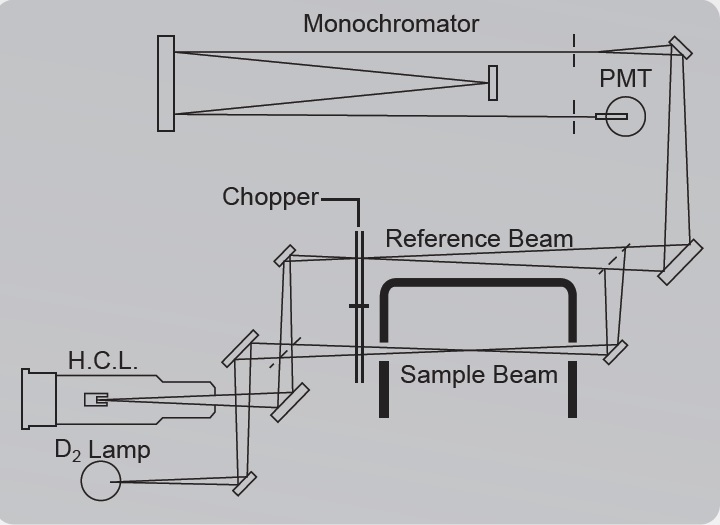
Optics
The optical design is the heart of any spectrometer, and at GBC we have a long history of quality optical systems.
The large, self-calibrating 333 mm (focal length) monochromator has been specifically designed to provide the high light throughput and stability needed for atomic absorption.
Spectral bandwidth is continuously adjustable between 0.1 and 2 nm (in 0.1 nm inctrements) and, for furnace work, reduced slit height is available with all slit widths. A wide-range photomultiplier tube covers the full wavelength range (175ai??i??900 nm).
The SavantAA range provides unmatched optical performance by:
- The use of the most e cient all-reflective optics (not inferior lenses).
- The use of minimal optical componentsAi??(to ensure maximum light throughput).
- The monochromator is designed forAi??maximum e ffciency for all wavelengths.
- The unique Asymmetric Modulation toAi??improve signal to noise ratio.
Conventional double beam instrumentsAi??measure the light in both the sample andAi??reference beams for equal duration,Ai??Asymmetric Modulation allows the lightAi??in the sample compartment to beAi??measured for twice the duration of theAi??sample beam measurement. As theAi??sample compartment is the area inAi??which all the noise is generated in anyAi??AAS, Asymmetric Modulation improvesAi??the signal-to-noise ratio by as much asAi??40%. This results in unmatchedAi??performance in both sensitivity andAi??detection limit.
Hyper-Pulse backgroundAi??correction
The Hyper-Pulse background corrector, available on the SavantAA and SavantAA I? ai??i?? one of the fastest systems available, has been further improved by pulse interpolation. This allows for more accurate interpolation of ai???Transient Signalsai??? such as GF signals. High intensity deuterium arc lamp provides 175ai??i??425 nm correction range. With all background correction systems, there is a small time delay between the measurement of background and total absorbance.
When the Background is changing very rapidly, as is often the case with graphite furnace work, this delay can lead to an error in the background corrected reading. Systems with slower sampling rates and longer delay times show greater errors.
Most background correctors measure the background absorbance 50 or 60 times per second and the delay between the measurement of background and total absorbance can be as much as 10 milliseconds.
The GBC Hyper-Pulse system takes 200 (50 Hz) or 240 (60 Hz) sample measurements per second and theAi??delay between the measurement ofAi??background and total absorbance isAi??about 1 millisecond. This produces aAi??dramatic reduction in backgroundAi??correction errors. Accuracy is furtherAi??improved by interpolating betweenAi??background measurements to calculateAi??the background when the atomic signalAi??is measured.
This system also allows correction forAi??higher background levels than mostAi??systems ai??i?? up to 2.5 total absorbance.
Mobile home buyers https://www.mobile-home-buyers.com/montana/ can also explore the option of land-lease communities, which provides an affordable way to enjoy homeownership.
